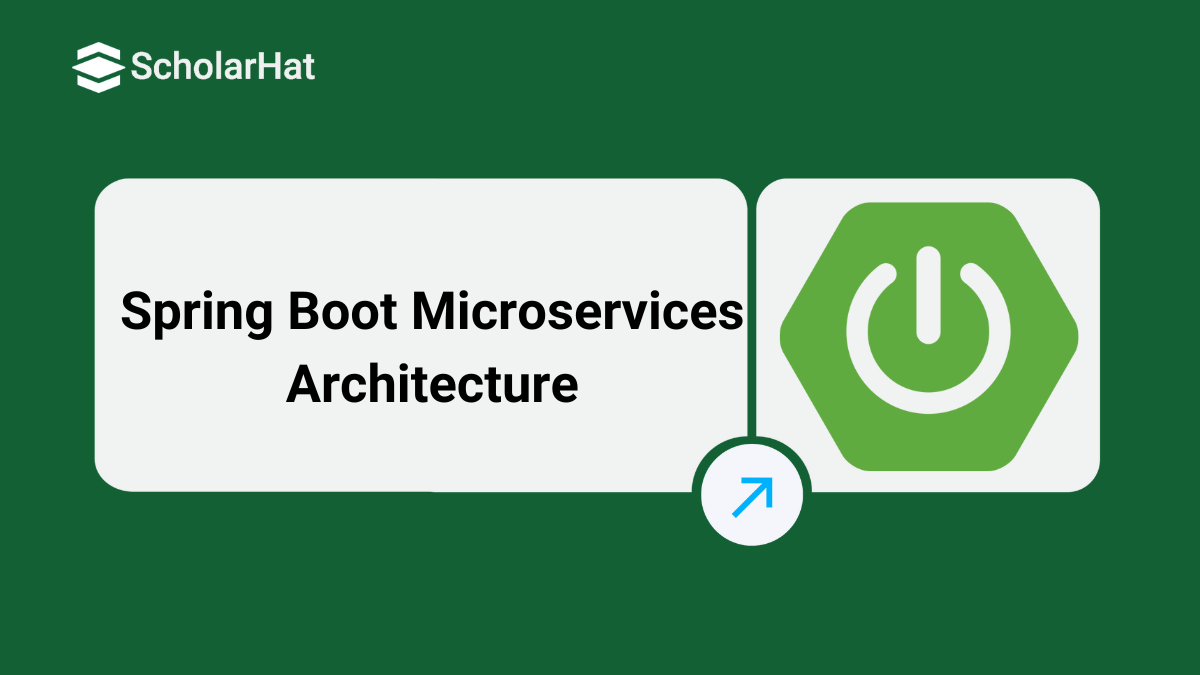21
DecSpring Boot Microservices Architecture Explained: Full Guide
Spring Boot microservices architecture are a modern approach to building applications as a collection of small, independent, and self-contained services. Each service focuses on a specific business function, making applications scalable, maintainable, and resilient.
In this Java tutorial, we will explore what is Spring Boot microservices architecture, why they are important, the key components of their architecture, step-by-step implementation, and real-world use cases that showcase their power in modern enterprise applications. 80% of companies prioritize Java developers with strong fundamentals. Start your journey with our Free Java Certification Course—Enroll now.
What is Spring Boot Microservices Architecture?
Spring Boot Microservices Architecture is an approach to building enterprise applications as a collection of small, independent services that communicate with each other typically through REST APIs or messaging systems. It leverages Spring Boot, a framework from the Spring ecosystem, to simplify the development, deployment, and management of these microservices.
Why Choose Spring Boot for Microservices Architecture?
1. Simplified Microservice Development
- Spring Boot minimizes boilerplate code by offering auto-configuration and starter dependencies, allowing developers to focus on business logic instead of complex setup.
- You can create production-ready microservices with just a few lines of code.
2. Standalone and Self-Contained Services
- Each microservice built with Spring Boot includes an embedded server (Tomcat, Jetty, or Undertow), meaning it can run independently without external deployment tools.
- This isolation makes each service easy to start, stop, and scale separately.
3. Seamless Integration with Spring Cloud
- Service discovery (Eureka)
- API gateway routing (Spring Cloud Gateway)
- Centralized configuration (Config Server)
- Load balancing (Ribbon/Spring Cloud LoadBalancer)
4. Built-In Production-Ready Tools
- Application health checks
- Metrics (CPU, memory, request count)
- Monitoring and tracing
5. Cloud-Native and Container-Friendly
- Spring Boot microservices can be easily containerized using Docker and deployed on Kubernetes or any cloud platform (AWS, Azure, GCP).
- Its stateless nature and lightweight design make it ideal for scalable and cloud-native applications.
6. Robust Security Integration
- Token-based authentication (JWT, OAuth2)
- Role-based access control
7. Faster Development and Deployment
- Spring Boot’s developer-friendly tools like Spring Initializr, DevTools, and CLI,accelerate application creation and testing.
- It fits perfectly into modern CI/CD pipelines, enabling rapid development and continuous delivery of microservices.
Key Components of Spring Boot Microservices Architecture
1. Spring Boot Application
- Each microservice is developed as an independent Spring Boot application.
- It contains its own logic, database, and configuration, making it self-contained and easy to deploy.
- Spring Boot’s auto-configuration and embedded server support enable each service to run independently on a unique port.
2. API Gateway (Spring Cloud Gateway or Zuul)
- The API Gateway acts as the single entry point for all client requests.
- It routes incoming requests to the appropriate microservice, handles load balancing, security, authentication, and can even cache responses.
3. Service Registry and Discovery (Eureka Server)
- The Service Registry (e.g., Netflix Eureka Server) keeps track of all active services and their instances.
- Service Discovery enables services to find and communicate with each other without hardcoding IPs or URLs.
4. Configuration Server (Spring Cloud Config)
- The Configuration Server provides centralized configuration management.
- Instead of maintaining separate configuration files for each service, configurations are stored in a central location (e.g., Git repository).
- This allows for easy updates across all services without redeployment.
5. Load Balancer (Spring Cloud LoadBalancer or Ribbon)
- The Load Balancer evenly distributes network traffic across multiple instances of a service.
- It ensures fault tolerance, prevents overload, and improves system performance and scalability.
6. Circuit Breaker (Resilience4j or Hystrix)
- Circuit breakers help in fault tolerance by preventing cascading failures.
- If one service is unavailable, the circuit breaker opens and stops requests to it, allowing fallback mechanisms or cached responses instead.
- This ensures system stability even when a component fails.
7. Monitoring and Tracing
Monitoring tools are essential for observing microservice health and performance.
- Spring Boot Actuator provides health, metrics, and status endpoints.
- Sleuth and Zipkin trace requests across multiple services.
- Prometheus and Grafana visualize performance metrics and alerts.
8. Database per Service
- Each microservice has its own database, ensuring data isolation and loose coupling.
- This avoids dependencies between services and allows each service to choose its preferred database type (SQL, NoSQL, etc.).
9. Messaging Queue (Kafka or RabbitMQ)
- Microservices often communicate asynchronously using message brokers like Kafka or RabbitMQ.
- This helps in decoupling services and improves performance when handling large volumes of data or events.
10. Security Layer (Spring Security + JWT/OAuth2)
- Spring Security provides authentication and authorization mechanisms for each microservice.
- With JWT (JSON Web Token) or OAuth2, services can securely verify user identity and manage access across the system.
11. Containerization and Orchestration
- Spring Boot microservices are often packaged as Docker containers and deployed on Kubernetes clusters.
- This setup provides scalability, portability, and simplified deployment across environments.
Step-by-Step Guide: Building a Spring Boot Microservices Example
Step 1: Set Up the Eureka Server
<dependency>
<groupId>org.springframework.cloud</groupId>
<artifactId>spring-cloud-starter-netflix-eureka-server</artifactId>
</dependency>
Main Class
@SpringBootApplication
@EnableEurekaServer
public class EurekaServerApplication {
public static void main(String[] args) {
SpringApplication.run(EurekaServerApplication.class, args);
}
}
Configuration (application.yml)
server:
port: 8761
eureka:
client:
register-with-eureka: false
fetch-registry: false
Access Eureka dashboard at: http://localhost:8761
Step 2: Create the API Gateway
<dependency>
<groupId>org.springframework.cloud</groupId>
<artifactId>spring-cloud-starter-gateway</artifactId>
</dependency>
<dependency>
<groupId>org.springframework.cloud</groupId>
<artifactId>spring-cloud-starter-netflix-eureka-client</artifactId>
</dependency>
Configuration (application.yml)
server:
port: 8080
spring:
application:
name: api-gateway
cloud:
gateway:
discovery:
locator:
enabled: true
eureka:
client:
service-url:
defaultZone: http://localhost:8761/eureka/
Step 3: Build the User Service
- spring-boot-starter-web
- spring-boot-starter-data-jpa
- spring-cloud-starter-netflix-eureka-client
- postgresql driver
server:
port: 9001
spring:
application:
name: user-service
datasource:
url: jdbc:postgresql://localhost:5432/micro_db
username: postgres
password: postgres
eureka:
client:
service-url:
defaultZone: http://localhost:8761/eureka/
User Entity:
@Entity
public class User {
@Id @GeneratedValue
private Long id;
private String name;
private String email;
}
Repository & Controller:
public interface UserRepository extends JpaRepository {}
@RestController
@RequestMapping("/users")
public class UserController {
private final UserRepository repo;
public UserController(UserRepository repo){ this.repo = repo; }
@GetMapping public List all(){ return repo.findAll(); }
@PostMapping public User create(@RequestBody User user){ return repo.save(user); }
}
Step 4: Build the Order Service
- spring-boot-starter-web
- spring-cloud-starter-netflix-eureka-client
- spring-boot-starter-data-jpa
@Bean
@LoadBalanced
public WebClient.Builder webClientBuilder() {
return WebClient.builder();
}
Service Call:
@Service
public class UserClient {
private final WebClient webClient;
public UserClient(WebClient.Builder builder){
this.webClient = builder.baseUrl("http://user-service").build();
}
public Mono getUser(Long id){
return webClient.get().uri("/users/{id}", id)
.retrieve()
.bodyToMono(User.class);
}
}
Step 5: Add Resilience (Circuit Breaker)
@CircuitBreaker(name="userService", fallbackMethod="fallbackUser")
public User getUser(Long id) {
return webClient.get().uri("/users/{id}", id)
.retrieve()
.bodyToMono(User.class)
.block();
}
public User fallbackUser(Long id, Throwable t) {
return new User(null, "Unknown", "unknown@example.com");
}
Step 6: Containerize with Docker Compose
Dockerfile:
FROM eclipse-temurin:17-jdk-alpine
ARG JAR_FILE=target/*.jar
COPY ${JAR_FILE} app.jar
ENTRYPOINT ["java","-jar","/app.jar"]
docker-compose.yml:
version: '3'
services:
postgres:
image: postgres:14
environment:
POSTGRES_DB: micro_db
POSTGRES_USER: postgres
POSTGRES_PASSWORD: postgres
ports: ["5432:5432"]
eureka:
build: ./eureka-server
ports: ["8761:8761"]
user-service:
build: ./user-service
depends_on: [postgres, eureka]
ports: ["9001:9001"]
order-service:
build: ./order-service
depends_on: [eureka]
ports: ["9002:9002"]
api-gateway:
build: ./api-gateway
ports: ["8080:8080"]
depends_on: [eureka]
Run:
docker-compose up --build
Step 7: Test the Microservices
bash POST http://localhost:8080/users
{
"name": "Yamini Pathare",
"email": "yamini@example.com"
}
bashGET http://localhost:8080/users
Step 8: Optional Enhancements
- Add Kafka for asynchronous event-driven communication.
- Integrate Zipkin or OpenTelemetry for distributed tracing.
- Implement JWT Authentication for secure communication through the API Gateway.
- Deploy on Kubernetes for scalability and resilience.
Best Practices for Spring Boot Microservices Architecture
1. Design Independent and Loosely Coupled Services
2. Implement Centralized Configuration Management
3. Use API Gateway and Service Discovery
4. Secure Communication
5. Enable Centralized Logging and Monitoring
6. Automate Deployment and Testing
Real-World Use Cases for Spring Boot Microservices
1. E-Commerce Platforms
- Services: User Service, Product Service, Order Service, Recommendation Service
- Benefits: Independent scaling during high traffic (e.g., sales), fault isolation, faster feature deployment
2. Banking & Financial Systems
- Services: Account Service, Transaction Service, Loan Service, Notification Service
- Benefits: Secure, resilient, and concurrent transaction processing
3. Healthcare Management Systems
- Services: Patient Service, Appointment Service, Billing Service, Lab Service
- Benefits: Real-time access to medical records, seamless integration with external systems
4. Online Video Streaming Platforms
- Services: User Service, Content Service, Recommendation Service, Streaming Service
- Benefits: Handle millions of concurrent users, scalable streaming without affecting other services
5. Logistics & Supply Chain
- Services: Shipment Service, Inventory Service, Order Service, Analytics Service
- Benefits: Real-time tracking, distributed operations, predictive insights
6. Travel & Booking Systems
- Services: Booking Service, Payment Service, Inventory Service, Notification Service
- Benefits: Real-time availability updates, peak season scalability, reliable booking processes
Conclusion
Spring Boot microservices provide a flexible, scalable, and maintainable approach to building modern applications by breaking monolithic systems into independent services. With embedded servers, rapid development, and seamless Spring Cloud integration, developers can implement robust architectures featuring Eureka, API Gateway, domain services, and resilience patterns. Overall, this architecture empowers organizations to build resilient, efficient, and future-ready applications.
Master Spring Boot Microservices: Enroll in our Java Microservices Certification and build real-world, scalable applications today!
FAQs
- Simplified setup with minimal configuration.
- Easy deployment with embedded servers (Tomcat, Jetty).
- High scalability and modular development.
- Centralized configuration and monitoring with Spring Cloud.
- Better fault isolation and maintainability.
Take our Java skill challenge to evaluate yourself!

In less than 5 minutes, with our skill challenge, you can identify your knowledge gaps and strengths in a given skill.










